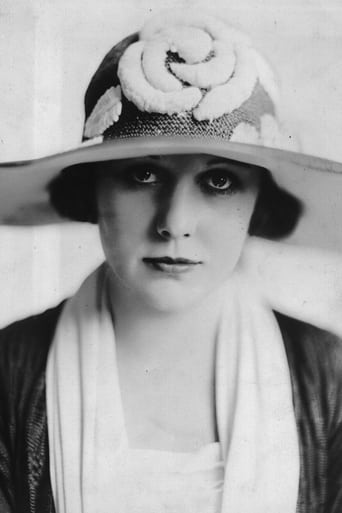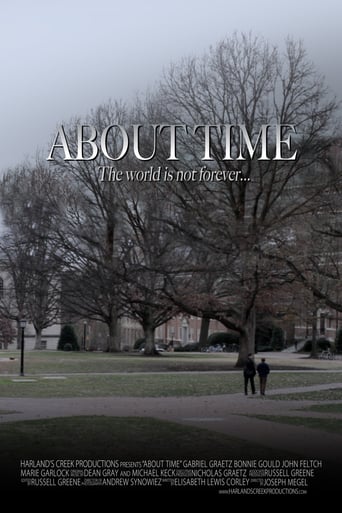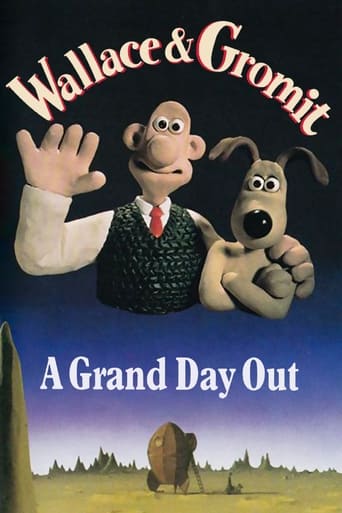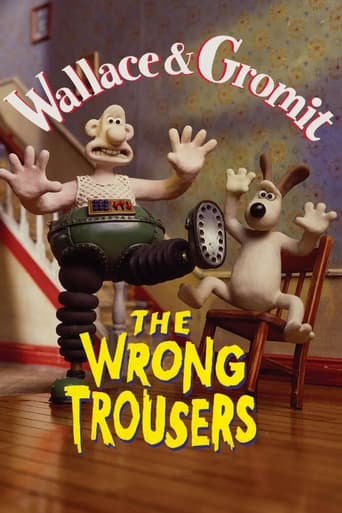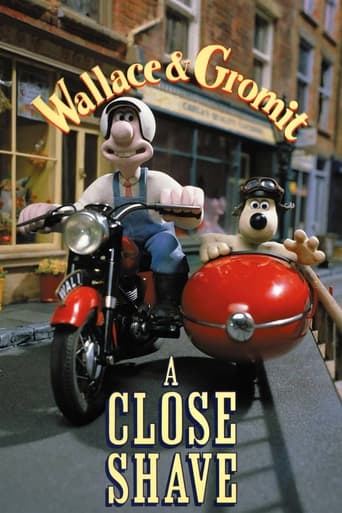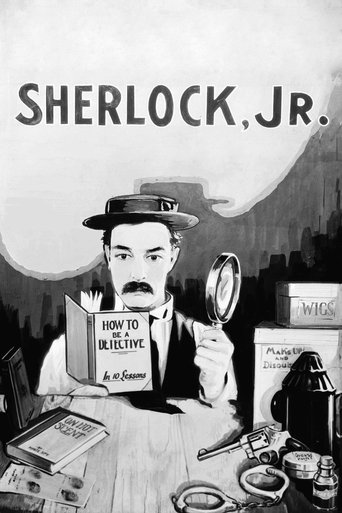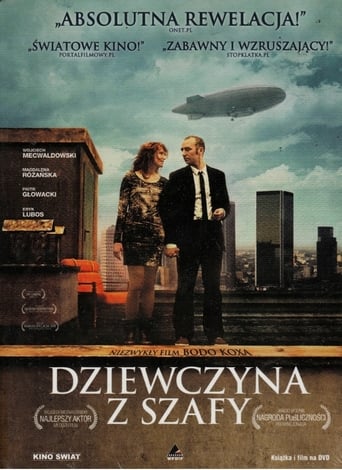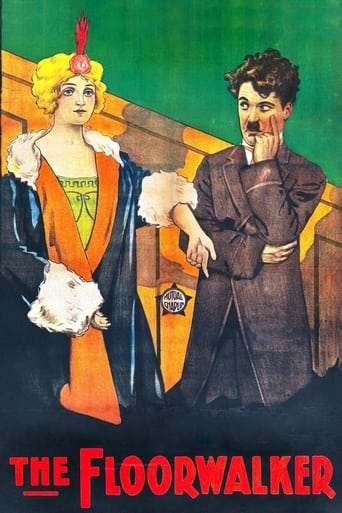
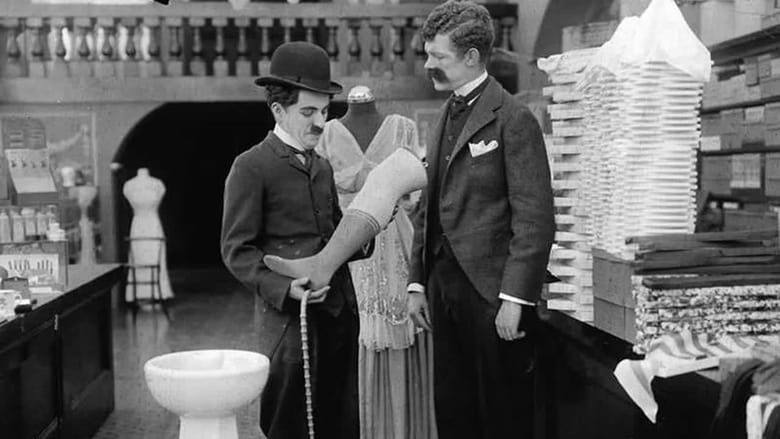
The Floorwalker (1916)
An impecunious customer creates chaos in a department store while the manager and his assistant plot to steal the money kept in the establishment's safe.
Watch Trailer
Cast
Similar titles
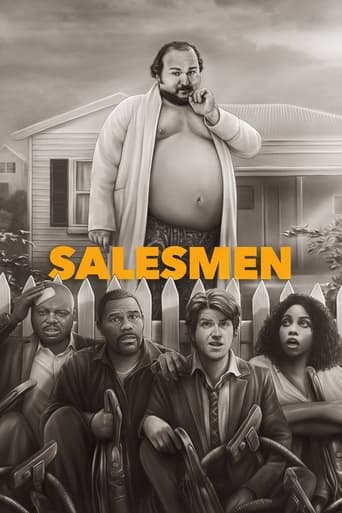
Reviews
You won't be disappointed!
Pretty good movie overall. First half was nothing special but it got better as it went along.
It's the kind of movie you'll want to see a second time with someone who hasn't seen it yet, to remember what it was like to watch it for the first time.
It’s sentimental, ridiculously long and only occasionally funny
THE FLOORWALKER (Mutual/Lone Star Company, 1916), Written and Directed by Charlie Chaplin, stars The Little Tramp in his first of twelve comedy shorts for Mutual (1916-1917). Coming a long way in a short time since his screen debut in 1914, Chaplin, now on his own, taking charge of his script and comedy material that has become genuine classics. Though some of his finest work in both short and feature-length formats were ahead of him, THE FLOORWALKER marked the new beginning in Chaplin's creativity and comical genius that developed with each passing film. Aside from Edna Purviance, Chaplin's frequent co-star since 1915, THE FLOORWALKER also marked the first of eleven comedies to pair the pint-sized Chaplin with the giant-sized Eric Campbell, a classic combination. A winning pair responsible for Chaplin's finest moments in screen comedy and new phase for the development of his tramp character that was to start here.Opening title: "The Big Store." The slight plot development introduces scenes involving a stern floorwalker (Lloyd Bacon) ordering his sales clerk (Albert Austin) about and a loyal secretary (Edna Purviance) working for her general manager (Eric Campbell). After Campbell reads some shocking news from a memo, he works on a diabolical plot of robbing the store safe along with his floorwalker. The floorwalker, however, turns against Campbell, knocking him unconscious only to take the full bag of money for himself. There's one setback, how to get out of the place without the store detectives watching. During a shoplifting spree from numerous bargain seekers, in comes a customer (Charlie Chaplin) causing trouble for the clerk and getting himself into mischief before going through a series of pratfalls up the down escalator. Evading store detectives, Charlie takes refuge in the manager's office where he comes face to face with his look-alike floorwalker thief. Wanting a job in the store, both men agree to switch clothes and identities, this leaving Charlie holding the bag and thief falling victim through a series of unforeseen circumstances.While not as crude as some of Chaplin's earlier comedies for both Mack Sennett and the Essanay Company, there's still some use of behind kicking and facial slaps to go around. Surprisingly, however, THE FLOORWALKER doesn't make use the traditional love match between Chaplin and Purviance. In fact, they share no scenes together whatsoever. Purviance's presence is devoted mainly towards her bearded, evil- eyed employer, Campbell. With a mannequin, water fountain and elevator playing part of prop comedy material, the one that gets the most attention is the escalator. Chaplin's ballet dancing technique where he avoids a fight is Chaplin style that's seldom imitated, never duplicated. However, the mirror bit between Chaplin and Bacon is one duplicated and imitated by other comedians over the years, the best re-enactment coming from the Marx Brothers twosome, Groucho and Harpo, doing it their way in the masterful production of DUCK SOUP (Paramount, 1933).Other than the gag material expected from Chaplin, THE FLOORWALKER makes good use with camera cutaways from one action to another. There's even a D.W. Griffith-type of extreme close-up reaction technique on the lady store detective (Charlotte Mineau) worth noting. Others seen in the cast include Bud Jamison, Leo White, James T. Kelly and Chaplin regular, Henry Bergman, doing a minor bit as an old man who blows his horn.An enjoyable twenty minutes that might have developed into a featurette, THE FLOORWALKER is as good as it gets. Along with the other Chaplin Mutuals, THE FLOORWALKER did have plenty of exposure on both commercial and public television broadcasts in the sixties and seventies with prints from 1930s reissue accompanied by jazzy music score and sound effects, the same prints acquired by Blackhawk and Republic Home Video for its video distributions in the 1980s and 90s. Interestingly, rather than placing these Chaplin Mutual comedies in order for which they appeared, Republic released these twelve Chaplin shorts in out sequence mix, placing THE FLOORWALKER as the second movie in the third of its four volume VHS sets. In recent years, THE FLOORWALKER has turned up on cable television, namely Turner Classic Movies (TCM premiere: December 13, 1999) with new orchestral scoring and silent acu-speed prints from Kino Home Video. Next in store of the Chaplin Mutual comedies: THE FIREMAN (1916) (***)
I have actually seen outtakes from this film in the TV miniseries UNSEEN CHAPLIN, and separately as a boy. It is one of the Tramp's finest performances, bar none, and features my favourite situation, a case of mistaken identity. The Tramp enters a huge department store and is mistaken for the title character, who is his exact double except for the fact that he is taller than him - and I'd like to know how Chaplin managed that! Eventually, of course, everything is straightened out, and the thieving floorwalker is arrested. One of the few times where Chaplin portrayed a villain, this is among the best of the short comedies he directed over the years.
This is the first picture Charlie Chaplin made at Mutual studios. After a year-long maturing period at Essanay, he had at last set off in search of greater creative freedom and vastly inflated salaries. This is precisely what Mutual gave him.The most obvious difference between the Floorwalker and the shorts that went before it is the level of confidence and cinematic professionalism Chaplin now displays. There is a lengthy opening sequence before the little tramp even appears, establishing the antagonists and the scam in which Charlie will later become embroiled. Eric Campbell is introduced with a formidable close-up, giving him a more menacing and memorable entrance. There's also a bit of bold cross-cutting, some of which becomes a joke in itself. For example, we cut back-and-forth from Albert Austin tussling with the essentially harmless Charlie, while behind his back a gang of thieves rob the store blind. That particular gag also shows his willingness to sometimes move the camera away from himself, making his little tramp the cause of the comedy but not the focus of it. These were all techniques Chaplin had used before, but never quite to this extent or with this much bravura.With a new studio came new supporting actors, and here we see the introduction of two very important figures in the Chaplin career. Most noticeable of these was the stupendous Eric Campbell, who fulfilled in the Mutual films the role of the bully. Campbell's appeal works on the old adage of "the bigger they come the harder they fall", but he's also a wonderfully expressive comedy character, all his movements looking comically exaggerated because of his size. The floorwalker also marks the debut of Albert Austin, who does a similar job to that of Billy Armstrong in the Essanays, that is, a lanky twerp for Charlie to wind up. He makes a good impression here, tumbling helplessly and striving to maintain his dignity. Fortunately, Chaplin brought across some of his best collaborators from the Essanay days, but Leo White and even Edna Purviance get a bit lost among all the new faces here. Honourable mentions go to Charlotte Mineau and Lloyd Bacon, both of whom had bit parts in a few Essanay pictures, now appearing in meatier roles.In spite of its technical polish and auspicious debuts, it has to be said that the Floorwalker is one of the less entertaining Mutual pictures. It has its moments (surely the best of which is Charlie's "mirror-image" routine with Lloyd Bacon, repeated years later by the Marx brothers in Duck Soup), but there is bit too much going on and a few too many characters, with not enough high quality comedy in between. Chaplin would have to do a little better than this to justify his hefty new pay packet.Still, let us not forget that all-important statistic – Number of kicks up the arse: 6 (3 for, 3 against)
So evidently the floorwalker is the guy that walks around the store making sure no one is shoplifting, which provides a wonderful situation for a little mixed identity. Chaplin plays an obnoxious browser, testing all of the products in the store and generally making a big mess without buying anything (this may be one of the few times in his career when he displayed a little understanding of the plight of the store owners dealing with pesky shoppers who don't buy anything). Soon, however, he is back to sticking up for the people. The floorwalker begins harassing Charlie while a real thief robs the place blind right behind him. There are two new and interesting things in this film. One is the escalator, which I have a feeling is the first escalator ever to appear in a motion picture (if you know of an earlier one, I'd be curious to hear about it), and the other is a Chaplin look-a-like. He's much bigger than the diminutive Chaplin, of course, but it's the first time I've seen his double appear with him in one of his movies. The escalator is well used here, as well. The humor surrounding it goes a long way, and Chaplin speed walking down it is one of the more memorable moments of his early career. Soon, the double, in his efforts to make off with a suitcase full of cash, pays Charlie to trade clothes with him (I am always suspicious of someone who wants me to wear their clothes out of a store), which Charlie foolishly accepts. The set up for the physical comedy is unusually clever in this film. The real bad guy gets caught and Charlie is congratulated for helping to capture him, then later an oafish guard wakes up (he had fallen victim to that silent film curiosity where someone gets knocked out and then later wakes up as though well-rested from a deep sleep), and comes after Charlie, unaware of his new hero status. He gives Charlie a hilarious thrashing.My favorite moment in the film is Charlie's brief farewell dance before he attempts to dive into that handbag. It reminds me of the prestidigitonious (something like that) scene in Sword in the Stone, one of my all time favorite animated films. There is a great scene near the end where Charlie does a hilarious little dance. It's hard to pinpoint it, but there is something definitely charming about the way he dances. I feel like I've seen a thousand other people do the same thing, and yet it still looks totally unique when he does it. The ending of this film is a little abrupt, but this is probably some of his best physical comedy yet.


